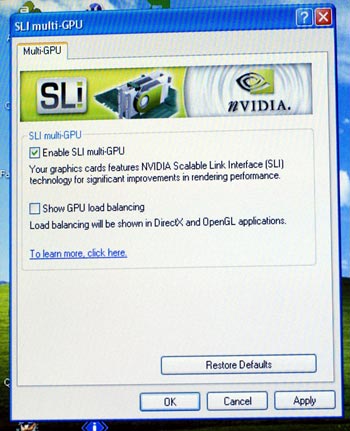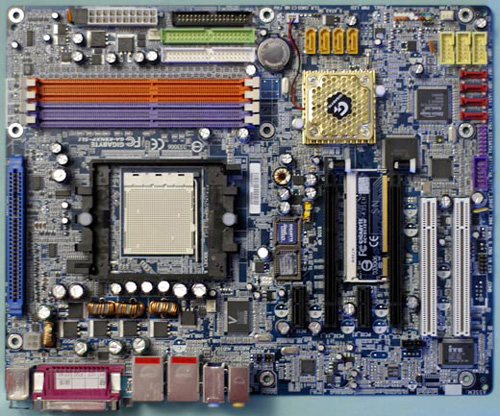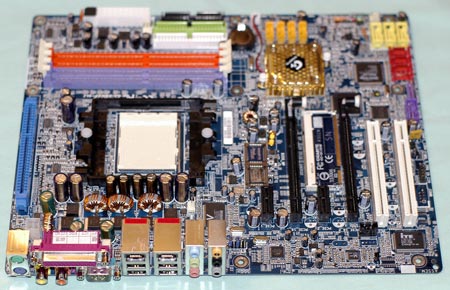FIRST LOOK: Gigabyte K8NXP-SLI
by Wesley Fink on November 24, 2004 9:00 PM EST- Posted in
- Motherboards
Features: Gigabyte K8NXP-SLI
Consider the K8NXP-SLI as an K8NXP-9 with SLI. Gigabyte has added all the BIOS options promised for the production boards and then some. Particularly interesting are the 0.5MHz increments available for very fine tweaking in the most used 200-270 CPU clock range, with 1MHz increments to the top speed of 400. The only item that proved too large a challenge for the production board was a wider range of memory voltages. Gigabyte states that future revisions of their nForce4 boards may see an increased memory voltage range, but that a boost in vDIMM options now would have required a board redesign. Gigabyte has tweaked the available vDIMM options to provide an adjustment range from 2.6V to 2.8V. As you will see in our overclocking tests, this had little impact on overclocking abilities, although a broader range is preferred and would have likely facilitated higher memory overclocking.| Gigabyte K8NXP-SLI Specifications | |
| CPU Interface | Socket 939 Athlon 64 |
| Chipset | nVidia nForce 4 Ultra (Single-Chip) |
| Bus Speeds | 200 to 400 200 - 270 in 0.5MHz increments 271 - 400 in 1MHz increments |
| PCI Express Speeds | 100 - 150 fixed in 1MHz increments |
| Core Voltage | 0.8V to 1.75V in 0.025V increments |
| CPU Clock Multiplier | 4x-20x in 1X increments |
| HyperTransport Frequency | 1000MHz (1GHz) |
| HyperTransport Multiplier | 1X, 2X, 3x, 4X, 5x, Auto |
| DRAM Voltage | 2.6V to 2.8V in 0.1V increments (Normal, +0.1, +0.2) |
| PCIe Voltage | Normal, + 0.1v, +0.2v, +0.3v |
| HyperTransport Voltage | Normal, + 0.1V, +0.2V, +0.3V |
| Robust Graphics Booster | Auto, Fast, Turbo |
| Memory Slots | Four 184-pin DDR DIMM Slots Dual-Channel Configuration Regular Unbuffered Memory to 4GB Total |
| Expansion Slots | 2 x8/x16 (Programmable) PCIe Slot 2 x1 PCIe Slots 2 PCI Slots |
| Onboard SATA/SATA RAID | 8 SATA Drive Total 4 SATA 300 Drives by nForce4 (RAID 0, 1, 0+1, JBOD) Can be combined with IDE drives in RAID 4 SATA 150 Drives by Sil3114CT176 (RAID 0, 1, 0+1, JBOD) |
| Onboard IDE/IDE RAID | Two Standard ATA133/100/66 (4 drives) Drives may be as IDE RAID or combined with nF4 SATA drives in a RAID Array |
| Onboard USB 2.0/IEEE-1394 | 10 USB 2.0 ports supported by nForce4 2 Firewire High-Speed 1394B by TI 46A9C3W |
| Onboard LAN | Dual Gigabit LAN On-chip Gigabit LAN by nF4/Cicada 8201 PHY PCI Express Gigabit LAN by Marvel 88E8053 |
| Wireless LAN | PCI 802.11b/g Wireless LAN Card Included |
| Onboard Audio | AC '97 2.3 8-Channel by Realtek ALC850 |
| BIOS Revision | Award K8NXP-SLI F2c 11/22/2004 |
The updated Gigabyte BIOS for the K8NXP-9/K8NXP-SLI family provides a very wide and useful range of adjustments for other features. Continuing with the Gigabyte custom in recent designs, Advanced Chipset Features (and Memory Timings) can only be seen when you press CTRL+F1 while in the BIOS. HyperTransport adjustments are also provided in the hidden Advanced Chipset Features menu.
There are no BIOS options for adjusting or controlling SLI. This is handled in the nForce4 platform drivers and the nVidia graphics drivers.
A new properties section appears in the Advanced properties GeForce tab for boards supporting SLI. This tells you that SLI is possible by installing a second video card. When the board between the PCIe video slots is turned to the SLI position and a second video card is installed with an SLI connector or bridge on top, new messages pop up telling you how to enable SLI.

The process is very easy, but don't assume that anything is wrong if you don't see SLI on the first boot. The first boot identified the video card. After we rebooted, the SLI was recognized and pop-ups led us though enabling SLI. The only boards currently working in SLI are the nVidia 6600GT, 6800GT, and 6800 Ultra. nVidia has stated that future 6800 video cards will also support SLI.
The Gigabyte K8NXP-SLI, like the sister K8NXP-9, was designed as a top-of-the-line nForce4 motherboard. As the flagship model, it sports all the top Gigabyte features.

The SLI version also supports the trademark DPS daughter to increase power reserves and stability by increasing the board to 6-phase power. You can see the DPS slot to the left of the CPU. You will also see dual BIOS chips to the left of the main PCIe video slot. This Gigabyte feature provides back-up BIOS in the event of a bad flash or unstable BIOS setting. The K8NXP-SLI can boot from the good backup BIOS if problems arise with the main BIOS.

Continuing the theme of "more than you might expect", Gigabyte provides eight SATA ports. Four ports are 3Gb/s ports provided by the nForce4 chip, and the other are four 1.5Gb/s ports driven by the PCI bus.
In the nForce4 family, Gigabyte adheres to nVidia's feature set. This time, we see Gigabyte use the nF4 on-chip Gigabit LAN by supporting it with a Vitesse (Cicada) Gigabit PHY. Gigabyte then goes one step further by including a second Gigabit LAN on the PCI Express Bus. This second LAN is also removed from the constraints of the slower PCI bus as it resides on the much faster PCIe bus.

Audio is AC '97 2.3, but Gigabyte uses the popular 8-channel Realtek ALC850. The K8NXP-SLI includes the same wide range of audio I/O provided on the K8NXP-9 to make the most of the 850 chip. This includes 6 programmable audio mini-jacks and coax SPDIF in and out - all on the rear panel. For more information on the Realtek 850, you can check the specifications at the Realtek web site.
Another pioneering feature for Gigabyte has been their support of high-speed 1394B Firewire on their boards. This continues with the K8NXP-SLI with 2 ports capable of 800MB/s. This is double the speed of 1394A, for those looking for fast Firewire access.
From a feature, board layout, and BIOS options point of view, the K8NXP-SLI can be considered the twin of the K8NXP-9. The only real change is the replacement of one PCI slot with a second PCIe video slot. All the good things about the features and layout of the K8NXP-9 are still here in the K8NXP-SLI.










58 Comments
View All Comments
BenSkywalker - Thursday, November 25, 2004 - link
"I would have to say that many of you are in the minority even when it comes to the visitors of this website, let alone computer games in general. Many gamers such as me don't care about the extreme resolutions. Heck, I don't really care that much about SLI."You pretty much summed up the issue with your comments right there. Those that aren't interested in extreme resolutions aren't interested in SLI either. Those of us that are interested in extreme resoltution are interested in SLI too.
darklight0tr - Thursday, November 25, 2004 - link
Some of the resolutions numbers being thrown around here are ridiculous! Anything above 1600x1200 I find extreme, and 1600x1200 should only be used with large CRT/LCDs. This is of course coming from me who runs a 19" CRT at 1024x768 because I don't like the looks of my monitor at any higher resolution.I would have to say that many of you are in the minority even when it comes to the visitors of this website, let alone computer games in general. Many gamers such as me don't care about the extreme resolutions. Heck, I don't really care that much about SLI.
I am glad to hear that someone is always pushing the envelope, though.
Myrandex - Thursday, November 25, 2004 - link
Awesome review. I don't know why everyoine is commenting on his resolution choices. Go read teh other SLI review, or read other SLI reviews from other websites such as the [H] or tomshardware. It looked like a sweet motherboard, and Fink this was a goiod review. There is one change I found though:Continuing the theme of "more than you might expect", Gigabyte provides eight SATA ports. Four ports are 3Gb/s ports provided by the nForce3 chip, and the other are four 1.5Gb/s ports driven by the PCI bus.
That should say nForce4 chip I believe. Its on the first or second page. Keep up the good work though,
Jason
Wesley Fink - Thursday, November 25, 2004 - link
#20 - As I have already stated, 1024 was for comparison to other motherboard benchmarks so, for example, you could see the base K8NXP-SLI is fast as a motherboard compared to other A64 boards. 1280 was included for SLI. Anand reviewed SLI graphics capability at 1600x1200 for those interested in those results.rslayerr - Thursday, November 25, 2004 - link
#22i was coming with that point man...yes i do have a 19" that can do 1600x1200,but at 60hz...wich is no way good since i "feel"the refresh rate thing and that is giving me headache,1280x1024 at 75hz is the minimum (75 hz) aaceptable.85 the best.so westley,yur right man...no point in doing it at 1600x1200 and up...
beside..some 19" does more hz at 1600x1200...but they are pricy!
R3MF - Thursday, November 25, 2004 - link
with the advent of HDTV spec panels, SLI is truly useful, and we need to know that SLI can drive modern games at these resolution (1920x1200).nserra - Thursday, November 25, 2004 - link
I never played games with monitor higher then 19", but is it really need AA with 1600x1200 or higher resolution? There are so many pixels that I doubt we see them (except maybe TFT).Why every one says that want to test the SLI at 2048x1536? Which monitor will do that with quality and frequency? Who have of those monitors right now?
1280x1024 75 Hz is not enough, at least 85 Hz is needed, and i think when the resolutions increases you need more Hz or your head will mess up! So where is a 2048x1536 100 Hz monitor? If exists do you really think it cheap?
Is this card ok for games of just work? http://www.3dlabs.com/products/product.asp?prod=29...
SLI = 5000$ PC
R3MF - Thursday, November 25, 2004 - link
i can understand the 1280x1024, as many people will have 17-19 inch LCD panels, or otherwise game at that res with their CRT, and for those hoping to get two 6600GT's then it makes a lot of sense, but 1024x768!i love anandtech motherboard grouptests, they are useful beyond many other sites. i look forward to an SLI grouptest where i would like to see the following resolutions benchmarked.
1280x1024 (6[b]6[/b]00GT SLI)
1680x1050 (6[b]6[/b]00GT SLI + 6800GT SLI)
1600x1200 (6800GT SLI + 6800[b]U[/b] SLI)
1920x1200 (6800GT SLI + 6800[b]U[/b] SLI)
2048x1536 (6800[b]U[/b] SLI)
BenSkywalker - Thursday, November 25, 2004 - link
Wesley- We are still waiting for the 6800NU PCI-E parts to arrive. You may have access to information and when that will be, but everything in the public domain indicates that we will be waiting for the NV41 revision and no firm street date(based on the public information). 6800NU in SLI as of now is something looming on the horizon.2x6600GT + NF4 SLI Premium is a bit higher then $400. 6600GT in an SLI configuration makes sense for those looking to do an upgrade now with a future viable path for them to take down the road to up performance again. It makes little sense to pay the premium for NF4 SLI w/dual 6600GTs when you can buy a 6800GT for less and avoid having to pay the premium for the SLI capable mobo. Their performance is close enough, and who has the performance edge depends on the settings although it is the 6800GT more frequently then not.
I think you are kidding yourself if you think that there are many people concerned over the performance difference of Halo running 1024x768 on any high end vid card setup. The game is quite limited at that setting by the processor/platform, certainly far more then the vid card(excluding a single 660GT). Those that have either a SLI setup or one of the higher end boards are going to be running at settings considerably higher then 1024x768.
For Aquamark3 I think you will find that pretty much noone cares one way or the other. The game the bench is based on is quite poor and already forgotten by pretty much everyone.
As far as the 6600GT performing close to the 6800U at 10x7 in D3, that is why I said you might as well have tested 320x240. You are processor/platform limiting the benches making the vid card varriable as small of a factor as possible. Most of the varriation we are seeing could easily be driver overhead- without stressing the parts we have no way of knowing how they are going to stack up in real world useage. Talk to some people who play games regularly and know even a little about computer hardware- ask them why they would spend $400(or signficantly more) on a video card. I can assure you that it is not to run 1024x768.
Wesley Fink - Thursday, November 25, 2004 - link
Comparing Doom3, Far Cry, and UT2004 results from the launch review benchmarks, the Gigabyte is significantly faster than the Asus SLI. However, Anand's benches were run at slower memory timings due to issues with the first SLI board - that were corrected with the second board he received. For that reason it was not completely fair to compare the Asus SLI benches to the Gigabyte SLI.The first thing tested on the Gigabyte was to compare stock 6800U results to other A64 tests we have run. We saw the Gigabyte SLI performing the same as the K8NXP-9 nF4, which is the fastest A64 board we have tested so far. To answer the question, the Gigabyte is a lot faster than the Asus as the Asus was tested. We will run benchmarks on the Asus SLI for comparison as soon as we receive the production board here for testing.
#18 - 2x6600GT it $400 total, 2x6800 is $600 total, 2x6800GT is $800, and finally 2x6800 Ultra is $1000. There are many SLI options other than 2 6800 Ultra and I believe many people do care that 2x6600GT performs faster than a single 6800 Ultra in Aquamrk 3 and Halo at 1024. In fact that $400 combo performs about the same as the more expensive single 6800 Ultra in Doom 3 at 1024.